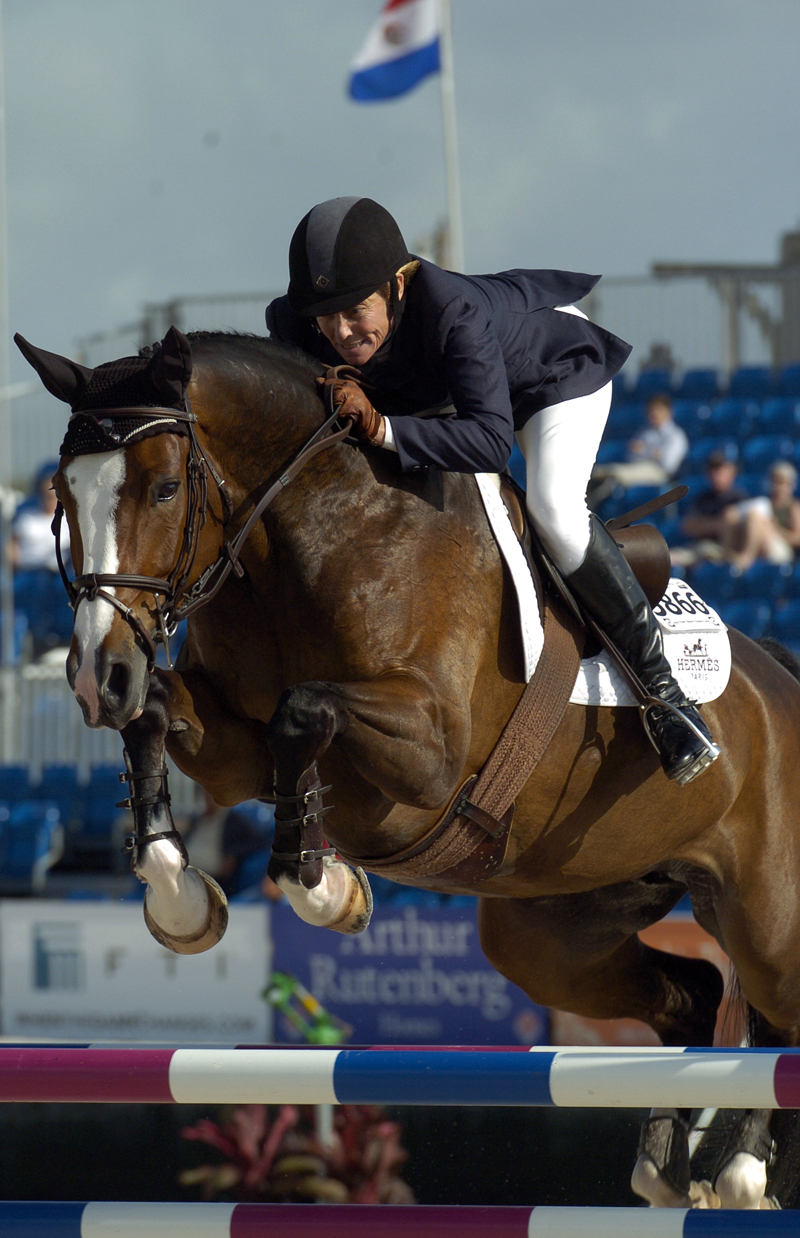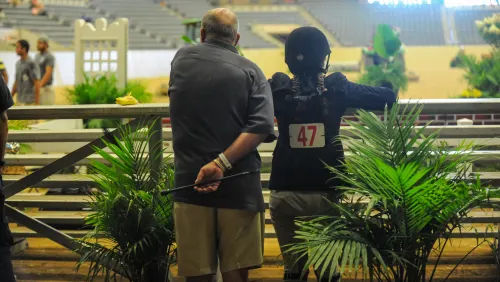There is an old saying: “There are two secrets to be successful in this business. The first: Don’t give away all your secrets.”
Some Masters guard their methods like a bag of cash, arm slung obstinately behind their back.
Anne Kursinski is not one of those people. Anne Kursinski’s Riding And Jumping Clinic: A Step-By-Step Course For Winning In The Hunter And Jumper Rings (Doubleday, 1995), details, in sometimes beautiful prose, every aspect of riding a jumping horse that one could reasonably expect to be included in a book. She has studied widely, and her writing reflects that.
- She instructs on the basics. On mounting: “As you swing your right leg down, feel for the right stirrup and lower your seat gently into the saddle—don’t just flop onto his back like a sack of potatoes.”
- She comments on flatwork. On the feeling she gets when riding on the bit: “I like to think of it as a little like plumping feathers in a pillow: your legs are almost tickling your horse, making him straight and forward and more animated; your seat is pushing a little, accentuating the natural motion of his back in the stride, telling him he’s got to be more active from behind; but your hand is saying, ‘I don’t want you to go faster; even though I’m asking for impulsion. I want you to let my hands package that impulsion, contain it, while you stay light and lively.’ ”
- And finally, she writes on jumping theory: “Your goal is to accompany him, not interfere with him. The great hunter and jumper riders appear to be at one with their horses—almost centaur-like—because they’ve mastered the art of noninterference. You want to master it, too.”
“I do!” I thought, as I read through her book.
One email was all it took to get in touch with Anne Kursinski. “Thanks for sending the video,” she said a few days later, calling me on her cell phone. “Why don’t you come down right away?”
She seemed nice and talkative, even strangely interested. “We could use you,” she said, “I’ll need some help with the horses in Florida, and I think you could learn a lot too.”
She asked me about what I’d done, what I wanted to do, how long I could come for. She answered all my questions.
And I wonder, is that the act of an elite professional, a busy horsewoman, an author, a trainer? Where are the secretaries, assistants? Where are the airs? One might predict that her approachability and honesty would be her downfall. But instead, her business and her horses continue to thrive.
There are, of course, rumors about Anne. “She’s tough,” people say, “real tough,” with a nod of the head and raised eyebrows, as if to say “I’m glad it’s you going and not me.”
ADVERTISEMENT
But to these people I ask “tough?” And they have no answer. Long hours, they might say, or detail oriented or high standards. And to them I say, “great.”
No one faults her riding, which is seemingly above reproach. While looking for a good place for me to go, my dad and I had a long conversation about what it means to be a Great Jumper Rider.
“It seems like there are only two ingredients necessary to compete at the highest level,” I said.
“What’s that?” he asked.
“An eye for a distance. And money.”
He laughed, “I guess so. And maybe a bit of training and athleticism thrown in. But what separates the competitors from the winners?”
A good question. Why are some people consistently at the top, on different horses and in different eras? Flatwork, theory, horsemanship, discipline?
Everybody can write, does that mean we are all writers? Just so, there are lots of people that ride horses, does that mean they are all Riders? And what separates the passing authors from the Orwells and the Atwoods. In what way does Anne Kursinski rise above the rest?
My guess would be this: She is detail oriented and has high standards. Her horsemanship and flatwork are great. And toughness. Toughness—no question about that.
ADVERTISEMENT
But is there something more? Is there some secret, some alchemy, that Masters practice behind closed doors and curtains of smoke, like the sorcerers of old?
Before I commit to going, I ask Anne one more question. “Is it OK if I write an article for The Chronicle of the Horse about my stay there?”
She doesn’t hesitate. “That’s a great idea,” she says. “I’d like to take a look at them first, but horses and the horse community have given me so much, and I love giving back.”
“Thanks,” I say. What more could I ask for?
“Great. I’ll book a flight today.”
“See you soon then,” she says. I hold the phone next to my ear while the connection clicks off.
Florida again, I think. West Palm Beach. This is gonna be it.
In the summer of 2008 Tik Maynard came up with a grand plan. He decided to spend a year working for some of the greatest horsemen he could find in different disciplines and writing about his experiences. So far, he has worked for Johann Hinnemann, Ingrid Klimke, David and Karen O’Connor and Bruce Logan. This article was written in January of 2010. For more information on Tik, visit www.tik.ca/.















